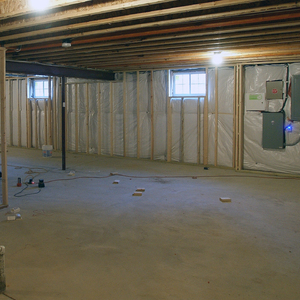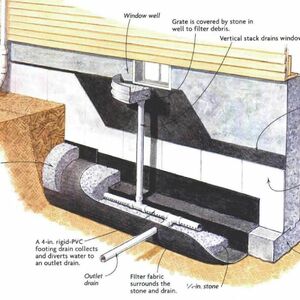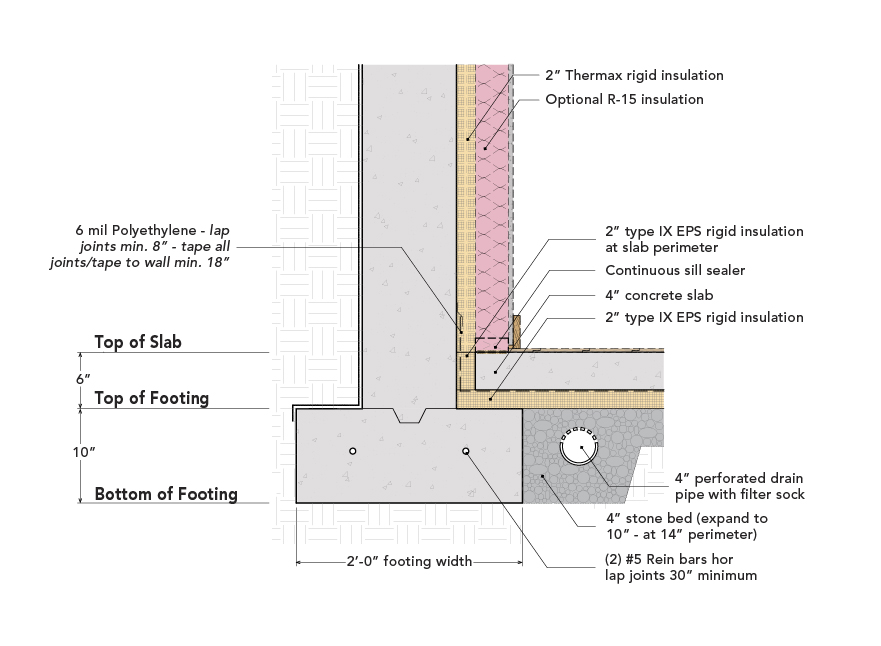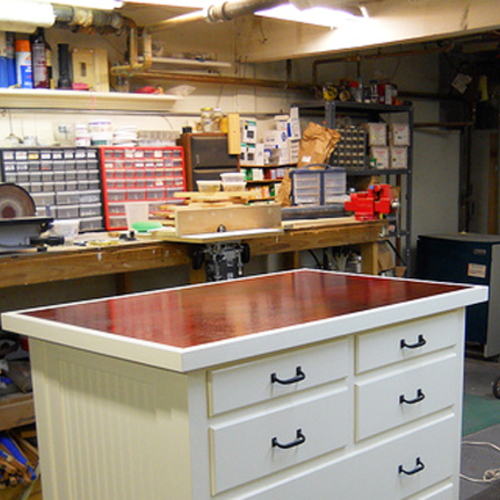
Growing up in New England, I thought that all houses had basements. Whether it had a dirt floor and stone walls or was a nicely finished space, in my mind basements were synonymous with foundations. And, I assumed that even the nicest of basements were ultimately doomed to flood.
In my memory, there was always a small pool of water in our unfinished basement, and it seems like one at a time, each of my friends’ finished-basement rec rooms, where we played ping-pong and watched movies, eventually suffered water damage and became wastelands that were never rebuilt. I also remember basements being cool, temperature-wise—a reprieve from summer heat, but a bit uncomfortable in the winter.
Basements are useful, but I’m not sold on them as the best foundation type, even in areas like the Northeast, where they are still common. And I tend to recommend that people proceed with caution when considering finishing an existing basement. That a basement be a dry space before it is finished is nonnegotiable. If you are not sure—as sure as you can be—that your basement will stay dry, don’t finish it. Humidity and moisture issues can be prevented with the right materials and mechanicals, but water will ruin your finished basement—slowly or quickly, but surely. To avoid problems with basements, we must build them right from the beginning.
It starts with the footing
It is common for basement walls to be built on top of a footing that is formed and poured. The footing sits below the frost line around the basement’s perimeter. We can’t talk about building a dry basement without talking about the footings because the cold joint between the footing and the basement walls is vulnerable to leaking water if water management details are not…
Weekly Newsletter
Get building science and energy efficiency advice, plus special offers, in your inbox.

This article is only available to GBA Prime Members
Sign up for a free trial and get instant access to this article as well as GBA’s complete library of premium articles and construction details.
Start Free TrialAlready a member? Log in















13 Comments
We completed a basement renovation last year. We replaced our basement slab, in our 1930 Tudor home, excavated an extra 12”, added filter fabric, drain pipes every 6’, and on perimeter, R-15 of XPS (due to space requirements), vapor barrier. We added metal chairs and hydronic tubes for floor heat across the full 1000 sqft.
On the outside we excavated 3/4 of the foundation wall, and did all the steps above with R-15 insulation, vapor barrier, and drainage.
The basement was regularly wet&flooding, it now is dry year round, even during the worst rains.
Our house is very much a WIP, I’m not sure we have seen a noticeable impact on energy use, but it’s so leaky still. We will get there.
That's a hell of a project Ryan. Glad to hear you have a better basement now.
Thanks! All the detailing came from GBA lots of Q&A here.
In the introduction to his thesis, Kohta Ueno wrote: “One observation consistently noted in studies and field investigations is that the failure of interior basement insulation is strongly linked to bulk-water leakage...
To put this in less-stilted language when I'm *not* writing an academic thesis: I've looked at boatloads of basements with bulk water issues, and then you walk around the outside, and the wet spot lines up with the downspout that's dumping water from half of the roof right next to the wall. Falls into the category of, "Yep, there's yer problem, lady."
Yes, but the same lady already got quotes from three different waterproofing contractors who told her that the only solution is to install interior perimeter French drains and three different sump pumps, even though they're already in place from the original construction. And she looks at you like you're crazy, because everybody knows that French drains are the answer to basement water issues.
When I was a bit younger, I went with my boss at the landscape construction company I was working for to visit some homeowers who wanted a curtain drain installed to stop their basement from flooding. As we walked around the house, I didn't understand why my boss seemed to be looking at the roof. When the homeowners came out to greet us, the first thing he said to them was, you don't need a "curtain drain, just fix your gutters." We never did install a curtain drain there, so I guess he was right.
Thanks for the follow up Kohta.
Brian, thanks for an excellent summary article. Lots of great information.
I had a question for the wider GBA community: Does anyone have data on footing capillary breaks and seismic shear resistance?
In our part of the world (Southern Vancouver Island), we would be using rebar to pin the walls to the footing, but I wondered if anyone had a study or a general engineering practice since this break might make the "cold joint" have even less friction.
I would think that this kind of question might come up in larger commercial structures?
John,
Given the high sheer strength of rebar embedded in concrete, I doubt the friction between the footings and slab of a cold joint contributes any significant amount to the resistance to lateral movement. I suppose you could compensate by increasing the reinforcing at the joint been the two, or forming a keyway in the footing as they used to.
Thanks, Malcolm. That makes intuitive sense.
In your experience, do your local code officials (or engineers) require any additional rebar to compensate? Does anyone check or care?
Similar to John's question above, what is the best practice for insulating under an interior basement shear wall? I will be starting a house in Seattle soon and the engineer has specified two interior walls in the basement that sit on 18" wide footers. it seems easiest to pour these footers in conjunction with the slab pour. Is it possible to insulate under these walls somehow?
Benji,
It is possible to insulate under any load-bearing concrete element if you use foam with the correct compressive strength. In the case of a shear-wall where continuity is very important, I'd imagine the insulation would have to go under the footing, not between the footing and slab. One compromise solution would be to pour the footing with a small stem-wall on it up to the level of the top of the slab, and insulate between the footing and slab. That would limit the uninsulated area. Of course all this is speculative - it's up to your engineer to decide how comfortable they are with any insulation, and the energy penalty for not including any is negligible in the PNW.
@Brian Pontolilo
@Kohta Ueno
This is the first article that I've seen that might reflect my basement construction since it mentions monolithic pours with no footing. I had a "basement system specialist" look at my house this week to discuss options for an interior drain. During heavy rains, I get a small amount of water staining around the perimeter (no puddle or bulk water issues).
It's a 100-year old double brick house near Toronto (cold climate). The foundation walls are 13-14" thick. I have no water issues through the walls or slab itself. The specialist's best guess for the foundation type is that it was a monolithic pour for the slab (no footings) and then they used wood planks as a mold to pour the walls onto the slab (you can see the horizontal lines where the planks were held and there are no penetrations). It looks to be in great shape with no structural issues. He's going to come back to drill pilot holes to try to confirm.
Two questions:
1. Does that sound right? I haven't seen any information about this type of construction technique. It may just be that I'm a rare type of house in my area.
2. Since an interior drain isn't an option, I'll do all of the recommended exterior stormwater management measures. 3 sides of the house are surrounded by a sidewalk, concrete patio, and veranda porch so I'd like to avoid exterior work if possible. Can I insulate the interior walls with EPS and leave an inch at the bottom of the wall and deal with the small amount of infiltration via dehumidification? The basement will always remain unfinished.
Great Article. One thing to note is that in any of the references to exterior insulation, no details ever show the interior finishing. Not just the details, no one really seems to mention exterior foam and how to finish the interior.
What is the client wants to finish the basement? Joe's views on drying to the inside make sense, however concrete like to be wet. (nothing around it does though). If we put rigid foam on the inside, then it will seal the foundation up and the water will really have no where to go. If we allow it to dry to the inside with a typical air gap and frost wall (Cold Climate zone Za) then we risk allowing extra unnecessary moisture into the basement that we don't want.
We are currently experimenting with 2" on the exterior of subterra foam, and planned to spray / rigid foam the interior. However, there are definitely opposing view points.
I will also mention that we are on a structural wood basement floor as well. That seems to throw a wrench into the discussion as well.
Thanks for any time and input.
Dan
Log in or become a member to post a comment.
Sign up Log in